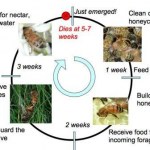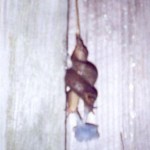animal behavior
tags: Phidippus putnami, Jumping Spider, macro video, animal behavior, streaming video
This remarkable video is of (probably) a sub-adult female Phidippus putnami Jumping Spider ..
Video: Thomas Shahan [Thomas Shahan's photostream]
tags: Paraphidippus aurantius, Jumping Spider, macro video, animal behavior, streaming video
After taking the video of an adult male Paraphidippus aurantius eating a cricket and waving his arms threateningly at the videographer's finger, both the male and an adult female P. aurantius were released on a nearby plant.
As stated in the video, the videographer did not intentionally cause the female to kill the male. The videographer says, "I was actually a little concerned that the female might try to get him, so I put them about three or four feet apart and went back inside for a little bit to…
tags: Tutelina species, Jumping Spider, macro video, animal behavior, streaming video
Here is some video (and stabilized from some really shakey footage using Deshaker, a plugin for Virtualdub) of male and female jumping spiders from the genus Tutelina. Not sure on the species, but the videographer's best guess is Tutelina elegans. The female could be mimicking the antennae movements of an ant. The music was recorded by the videographer.
Video: Thomas Shahan [Thomas Shahan's photostream]
tags: Phidippus princeps, Jumping Spider, macro video, animal behavior, streaming video
A nice little Phidippus princeps "chewing" on her (his?) feet, cleaning her eyes, and her fangs. Lots of fun palp movement, and a few glimpses of fang.
Video: Thomas Shahan [Thomas Shahan's photostream]
tags: ant mimic, Jumping Spider, macro video, animal behavior, streaming video
Unfortunately, no species ID yet (can you ID this spider?), but the mimicry in both form and behavior is truly beautiful, astonishing, really.
Video: Thomas Shahan [Thomas Shahan's photostream]
tags: Phidippus audax, Jumping Spider, macro video, animal behavior, streaming video
A macro video of a very large (15mm or so) adult female Phidippus audax jumping spider that the videographer found in a light fixture. Set to a recording he made in December with a vintage Japanese Alvarez classical acoustic and a Kay Swingmaster hollowbody electric.
Video: Thomas Shahan [Thomas Shahan's photostream]
tags: Phidippus apacheanus, Jumping Spider, macro video, animal behavior, streaming video
There's a chance he could be a male Phidippus cardinalis -- a bit of research reveals both P. apacheanus and P. cardinalis are found in this area of Oklahoma.
Video: Thomas Shahan [Thomas Shahan's photostream]
tags: Phidippus mystaceus, Jumping Spider, macro video, animal behavior, streaming video
This macro video of an adult male Phidippus mystaceus Jumping Spider is really interesting. He does have an inordinate fondness for jumping onto the camera lens, though! Jumping spiders are my favorite types, although they do awaken my inner phobia at times.
Video: Thomas Shahan [Thomas Shahan's photostream]
Professor Nicky Clayton researches the social behaviour, intelligence and dance credentials of birds! As an accomplished dancer in her own right she has fused her passions by collaborating with Rambert Dance Company to produce a Darwinian inspired ballet called The Comedy of Change.
L. David Mech is a famous wolf researcher (and a blogger about his research). If you have heard of a concept of "alpha-male" it is because of ideas from an old book of his, about social structure of wolf societies.
However, most of the early research on wolves was done on artificially built groups, e.g., wolves caught in various places all put together in a single wolf pen at a zoo. In such rare and unnatural situations, these stranger-wolves do indeed form social hierarchies (or "pecking order" - a term that arose from studies of chickens). But such situations rarely if ever happen out in…
tags: Walk On The Wild Side, animals, behavior, humor, streaming video
Walk On The Wild Side is a brand new comedy series that seeks to provide a long overdue forum for the views and opinions of the animal kingdom [1:54]
BATS use sonar, or echolocation, to navigate complex environments, and also to forage and then accurately pinpoint the flying insects on which they prey. Insects in turn have evolved various counter-measures to evade capture. Some species have ears which are in tune to the echolocation signals, while others are capable of performing complex evasive flight maneuvers in response to the clicks produced by attacking bats.
Tiger moths have evolved the ability to produce ultrasonic clicks in response to attacking bats. However, the function of these clicks was unclear, although decades of research…
Most people are aware that social insects, like honeybees, have three "sexes": queens, drones and workers.
Drones are males. Their only job is to fly out and mate with the queen after which they drop dead.
Female larvae fed 'royal jelly' emerge as queens. After mating, the young queen takes a bunch of workers with her and sets up a new colony. She lives much longer than other bees and spends her life laying gazillions of eggs continuously around the clock, while being fed by workers.
Female larvae not fed the 'royal jelly' emerge as workers.
Workers perform a variety of jobs in the hive.…
I know PZ has recently posted a picture and a video of slugs mating. But these pictures were taken here in North Carolina, by blog reader Kris Barstow, who says:
The year was 1999 plus or minus a year, the site was a few miles from Asheboro, NC. I don't recall the season, but it was warm, and there is definitely a chill there in the cold seasons, so I assume spring or summer. It was about half an hour after sunrise; I was walking my dog. I would occasionally carry my camera "just because ..."
I saw these two acting strangely on the surface of the wooden shed. They actually attached themselves…
If you missed it before, I have written about this kind of research before - this is interesting stuff, as much as the video is just plain funny (video, hat-tip: Psique).
tags: Eurasian Jackdaw, Corvus monedula, body language, behavior, peer-reviewed paper
Eurasian Jackdaw, Corvus monedula.
This is the smallest species of corvid (crows and ravens).
Image: Wikipedia [larger view].
Those of you who go birding will know what I am talking about when I say that birds are so capable of reading human body language that they know when we are looking at them, which frequently causes them to hide from our gaze. However, this capacity has never before been scientifically studied in birds, until now, that is.
A newly published paper studied handraised, tame…
tags: captive dolphins, SeaWorld Orlando, bubble ring, animal behavior, streaming video
This streaming video shows the dolphins at SeaWorld Orlando's Dolphin Cove as they artfully create and play with underwater bubble rings and hear what SeaWorlds trainers, educators and guests have to say about this fun and fascinating behavior [3:25]

